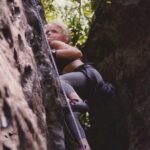Climber Problems: Ankle Injury. It’s that time of year again when the air gets crisp and the friction is perfect. It’s time to hang up those ropes and cram your bouldering pads in the trunk! With the seasonal transition, many of you will be heading out to boulder. While bouldering is fun, it has different elements that can lead to injuries— gravity and the ground! These annoying forces make ankle sprains one of the most common injuries in athletics and recreational activities.

Today our friend and physical therapist Kristen DeStefano are back. This month she shares a timely article teaching us everything we need to know about an ankle injury.
While many of us have turned an ankle and have been able to brush it off, repeated injuries or more severe injuries can lead to chronic ankle pain and instability when they go untreated.
Learn how to deal when you are on the injured list with cruxcrush.com
Glossary of Ankle Injury Terms
Before we get into it, let’s just review a few key terms you will need to know to understand all the different movements of the ankle:
Dorsiflexion– the movement of the foot upward towards the head
Plantarflexion– the movement of the foot down towards the floor
Inversion– Inward movement of the foot towards the other foot
Eversion– Outward movement of the foot away from the other foot
Supination– a combination of dorsiflexion and inversion of the ankle that raises the arch of the foot
Medial– on the inside aspect of the body
Lateral– on the outside aspect of the body
Ankle Anatomy
The ankle is actually made up of two joints, the talocrural joint, and the subtalar joint. These joints work together to allow your foot to move up, down, in, and out. The talus is the primary bone that people think of when they picture the ankle. It is a square-shaped bone that sits between the tibia and fibula (making the talocrural joint), rotating forward and backward for the foot to point up and down.
Below the talus is the calcaneus, which is the heel bone. The calcaneus tips side to side below the talus (subtalar joint) and lets the foot move inward and outward. To provide stability to these joints, ligaments help to prevent excessive movement. Ligaments are fibrous bands of tissue that connect bone to one another. On the lateral aspect of the ankle three ligaments exist to prevent the foot from rolling inward. They are the anterior talofibular ligament (ATFL), calcaneofibular ligament (CFL), and the posterior talofibular ligament (PTFL).
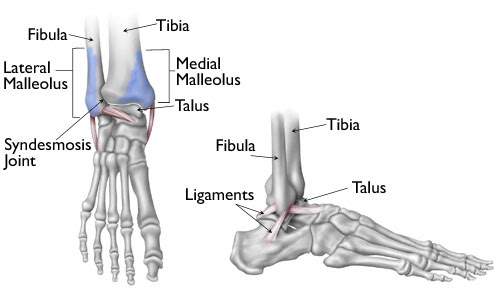

Why Are Ankle Injuries So Common In Climbing?
Ankle injuries will most frequently occur when the climber takes a high and unbalanced fall onto the crash pad or on a rope with a hard catch that slams the climber feet-first into the wall. These injuries can be combated with proper use of crash pads, a competent spotter, or a good belay with a soft catch. Unfortunately, climbing shoes also put us at a higher risk of ankle injuries, compared to when we are wearing street shoes. As climbing shoes have become more specialized, many climbers will use shoes with an asymmetrical shape or a downturn.
These shapes, combined with a tight shoe scrunching up the toes, put the foot in a more supinated position, raising the arch of the foot. The foot then becomes shortened, changing its biomechanics and reducing its ability for shock absorption. This means, that when a fall is taken the arch does not have room to lower, lengthening the foot and reducing impact, thus resulting in an inward rotation of the ankle.
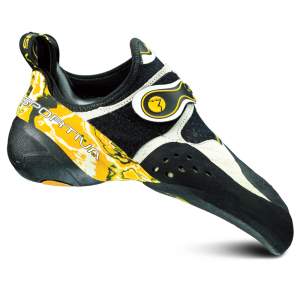
Climbing shoes put our feet in a great position for our sport, but not so great when it comes to absorbing impact.
Lateral Ankle Sprains
Ankle sprains can occur from falling from a boulder problem or just simply from a misplaced step while walking. Although it may range in severity, ankle sprains are usually the same regardless of the activity. In about 85% of ankle sprains, the foot is turned inward while pointed down. This is the least stable position for the ankle and most commonly damages the ATFL. When the foot is instead forced upward while being turned in, more force is required to damaged ligaments. However, in this case, damage to more than one ligament is likely, and more severe injuries, such as ankle fractures can occur.
Lateral ankle sprains, like many ligament injuries, occur in three grades of severity. Grade I is a mild injury where the ligament is stretched but not torn. Typically, there is low-grade pain, minimal swelling, and little to no limitations in inactivity. Grade II is a sprain involving a partial tear to the ligament. This will cause moderate to severe pain, marked swelling, slight bruising, and limitations to activities including walking. Finally, a Grade III sprain is when a complete tear of the ligament occurs.
With Grade III lateral ankle sprains the ATFL and the CFL are typically torn together. Here, severe pain, bruising, and swelling are present. The majority of people are then unable to bear weight on the ankle immediately after injury. In these cases, X-rays may be taken to rule out a possible ankle fracture.

Ankle Fractures
The most common kind of ankle fracture is a malleolar fracture. The lateral malleolus and the medial malleolus are the round bumpy protrusions on either side of your ankle. These injuries occur when the foot is twisted or rotated or with severe rolling of the ankle. During bouldering, this can occur when someone takes a fall and one foot rolls off the edge of a crash pad or gets stuck in between crash pads, or with a fall that is off-centered and the climber can not get both feet underneath their body.
Malleolar fractures are classified by which malleoli are fractured (medial malleolar fracture or lateral malleolar fracture). If both are fractured by the same injury, this is called a bimalleolar fracture. In the most severe of ankle fractures, a trimalleolar fracture can occur. This injury can be confusing as the “third malleolus” is considered to be the lower backside of the tibia (shin bone). If one of these bones is broken but still in line, a leg cast may be the only requirement to allow it to heal. In bimalleolar and trimalleolar fractures pins, plates, and screws are surgically used to realign the bones and fixate them in place.
Casting or the use of a boot is then used to let the bones heal back together.
Another bone that is at high risk of fracture when climbing is the talus. Talar fractures can occur with a high-velocity fall twisting the ankle when it is in a max upward position. The talus is jammed into the joint and fractured due to the twisting motion. This kind of injury can be subtle and often missed on X-rays, commonly being misdiagnosed as an ankle sprain. This can result in a non-healed or poorly healed bone leading to chronic pain or serious complications such as “avascular necrosis” (death of bone tissue due to lack of blood supply). Because of this, many talus fractures require surgery and should not be prematurely ruled out during diagnosis.
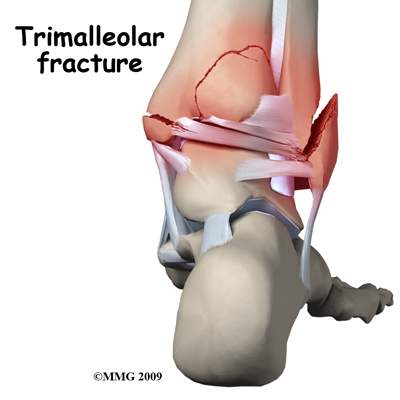
Well, How Can I Tell If It’s Broken?
Let’s face it when climbing injuries occur we are usually stuck in the woods. Particularly with leg injuries it may be hard to hike out with a severely sprained or broken ankle. If you were to go to the emergency room, medical practitioners would use what is called the Ottawa Ankle Rules to determine if X-rays were needed to rule out a fracture. The Ottawa Ankle Rule states that “an ankle X-ray series is only required if” there is any pain in the malleolar zone with one of the following findings:
1. bone tenderness at the posterior edge or tip of the lateral malleolus,
2. bone tenderness at the posterior edge or tip of the medial malleolus, or
3. inability to bear weight both immediately following injury and in the emergency department.
While seeking medical attention is preferred following any injury, this may be a helpful tool to determine how emergent the care is needed. Additionally, and obviously, ankle fractures are very likely if there is a noted deformity to the resting position of the foot and ankle.
Treatment and Recovery
Immediately following an ankle sprain, the PRICE method of treatment should be followed— Protection, Rest, Ice, Compression, and Elevation. If your symptoms do not improve within a few days of this conservative treatment and you are still having difficulty putting weight on your foot, you should contact a doctor for an evaluation. For fractures, particularly those that required surgery, the foot will be cast anywhere between two and eight weeks. The length of time depends on the type of injury and the healing time of the bones.
X-rays may be taken in the healing process to ensure proper alignment. From here, you will likely be referred to physical therapy. A physical therapist will promote early movement of the ankle, as tolerated, to regain lost motion and prevent further stiffening of the ankle. When you begin walking, assistive devices, such as crutches or a walking boot, may be needed. It is not uncommon to be unable to put full weight on your foot for up to two to three months. Weight-bearing too soon on a fractured ankle can result in the shifting of the bones. This will then extend the full recovery process.
Ankle sprains will heal quicker than fractures, however early and excessive weight-bearing can result in persistent pain and swelling. This may also prolong healing depending on the grade of the sprain.
Regardless of sprain or fracture, you will eventually be able to begin gentle but progressive strengthening exercises, as tolerated. Strengthening the muscles that evert the foot and those that dorsiflex the ankle is most important to prevent recurrent or future ankle injuries. If weak, the muscles that invert the foot and plantarflex the foot may also be strengthened in PT.

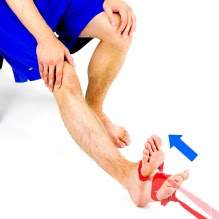
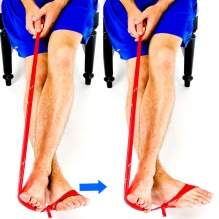
Finally, joints and ligaments have special receptors that communicate with our brain to provide information about where our body is in space. This is called proprioception. When these tissues become damaged, this sense can become impaired, reducing our ability to balance for periods of time or to react to changes in balance. To regain this awareness, static balance exercises can be performed, such as standing on one foot. This can be made harder by closing your eyes or by standing on a softer surface, such as a folded towel or pillow.
Working on dynamic balance is also important to improve the muscle’s reaction time. Dynamic balance exercises can be performed by moving the torso and arms while standing on one foot, for example picking up items off the floor or catching and throwing a ball to another person.

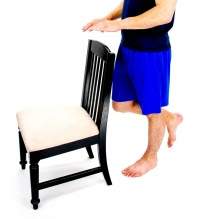
Research supports the use of physical therapy as the preferred method of treatment to prevent recurrence of injury and earlier return to activity, compared to immobilization and rest only. Therefore, to get back to the crag as quickly as possible, do not hesitate to seek treatment early on to allow for proper diagnosis and injury management.
Climb safe and climb on!
-Kristen
Kristen DeStefano, PT, DPT, graduated from Ithaca College with a B.S. in Clinical Health Studies and a Doctorate of Physical Therapy (DPT). She currently practices at Beantown Physio in West Roxbury, Massachusetts.
Thanks to Kristen for another informative post! If you have an injury you want to learn about, leave us a comment or send us an email at cruxcrush(at)Gmail(dot)com and we’ll get Kristen on the task.
Photo Credits: Nucleus Communications Inc, American Academy of Orthopedic Surgeons, Backtothebox.com , physio-pedia.com, HEP2Go.com






